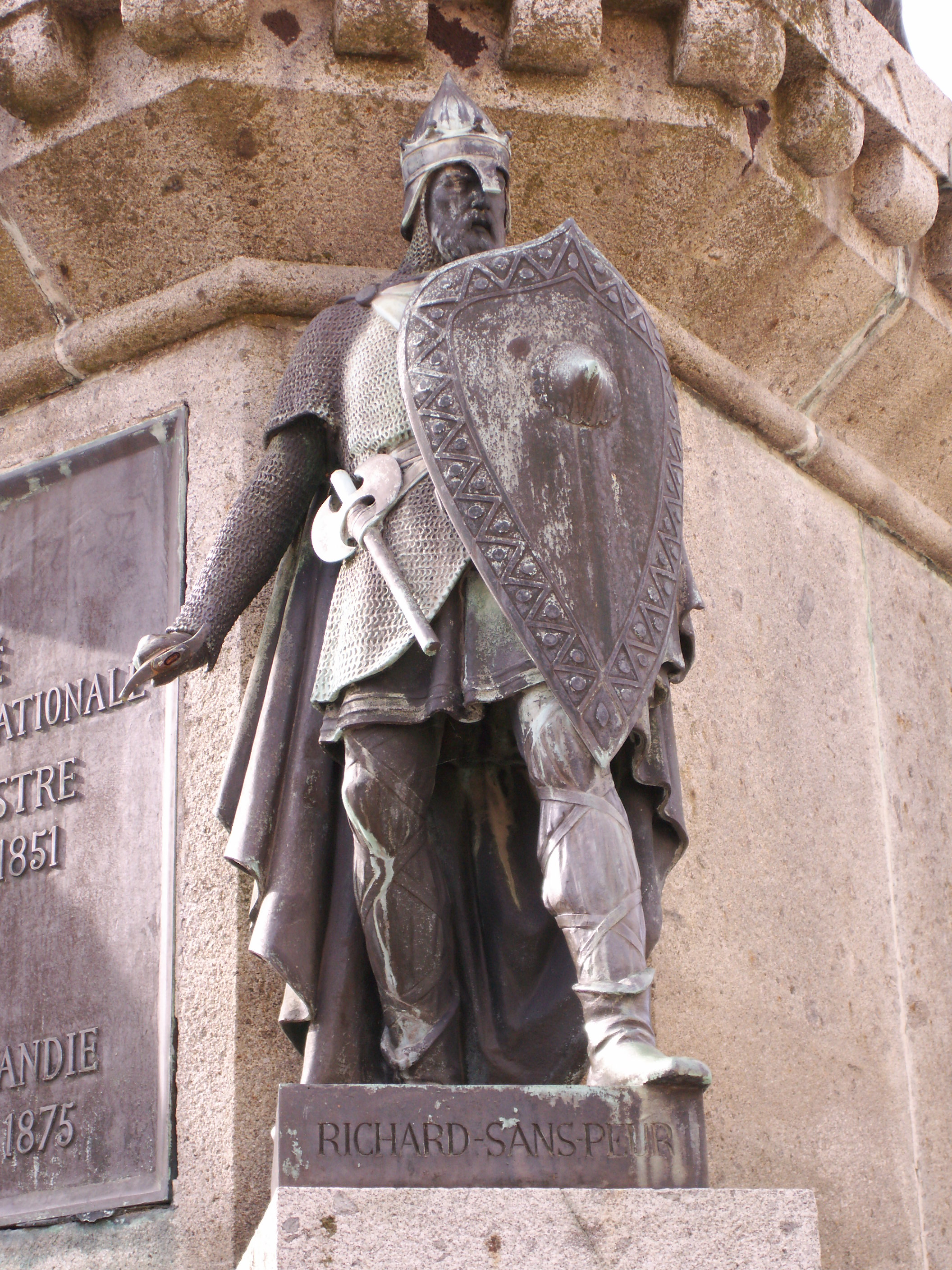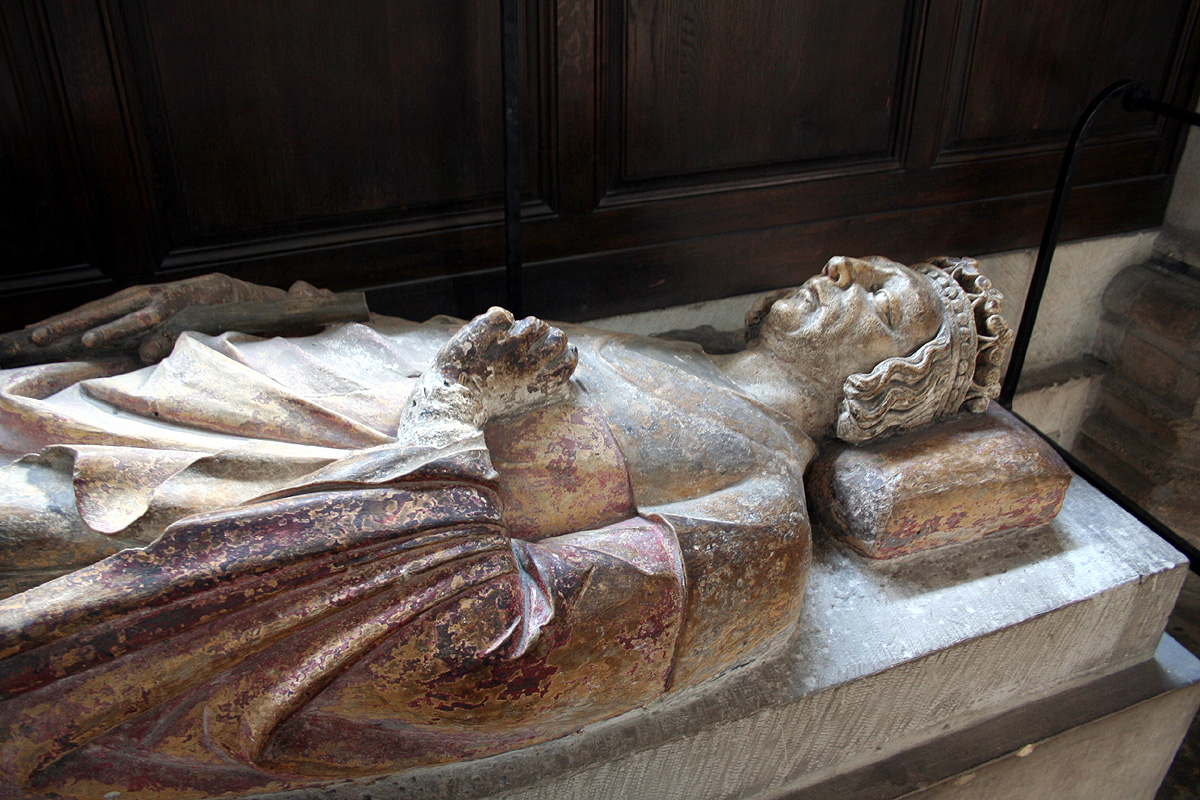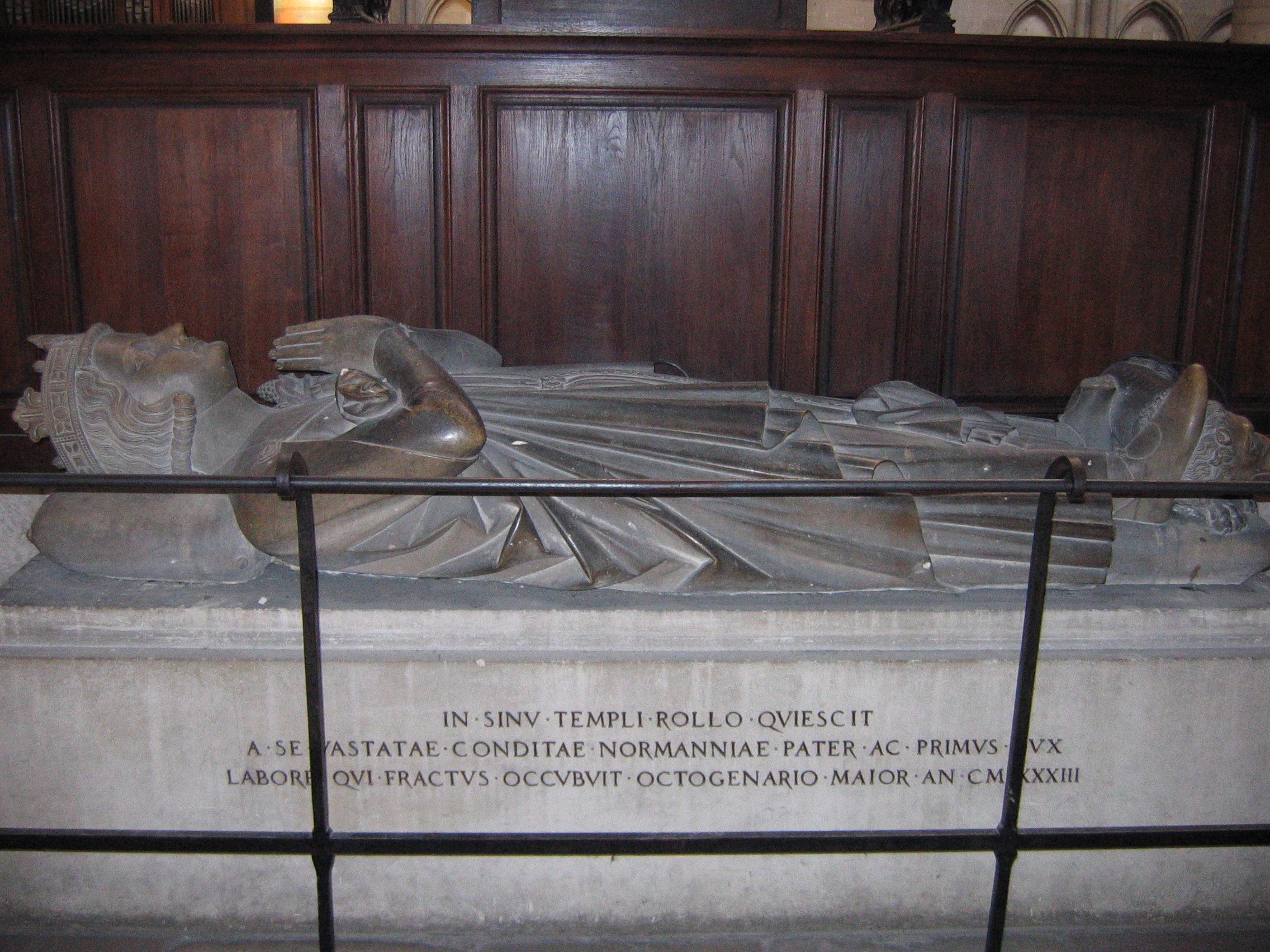Geoffrey, Count of Eu and Brionne
was an ancestor of FRANCIS CLAPHAM of Hunslet (born 1663) and the 28th great-grandfather of ELIZABETH ANN JOHNSON (1875-1948), mother of WILLIAM HENRY FLUEN (1906-1969).
 He was a son of DUKE RICHARD I of Normandy by an unnamed wife or concubine. The county of Eu was an appanage created for Geoffrey in 996 as part of his policy of granting honors and titles for cadet members of his family. The citadel of Eu played a critical part of the defense of Normandy; the castle and walled town were on the river Bresle, just two miles from the English Channel. It had long been an embarkation point for England and in time of war was often one of the first places attacked. In 1050, William, Duke of Normandy, the future William the Conqueror and king of England, married Matilda, the daughter of the Count of Flanders, at the chapel of the castle in Eu.
He was a son of DUKE RICHARD I of Normandy by an unnamed wife or concubine. The county of Eu was an appanage created for Geoffrey in 996 as part of his policy of granting honors and titles for cadet members of his family. The citadel of Eu played a critical part of the defense of Normandy; the castle and walled town were on the river Bresle, just two miles from the English Channel. It had long been an embarkation point for England and in time of war was often one of the first places attacked. In 1050, William, Duke of Normandy, the future William the Conqueror and king of England, married Matilda, the daughter of the Count of Flanders, at the chapel of the castle in Eu.
The castle of Brionne had been held by the Dukes of Normandy as one of their own homes but Richard also made a gift of Brionne to Geoffrey, who held it for life passing it to his son Gilbert and was only returned to the demesne of the Duke after his murder.
Both Geoffrey (Godfrey) and his son Gilbert are styled counts in a diploma to Lisieux, but without territorial designations. Geoffrey died c. 1010.
 His father, DUKE RICHARD I of Normandy was born in Fécamp, Normandy on 28. August 933 and died there 20. November 996. He was also known as 'Richard the Fearless' (photo: statue in the Falaise town square as part of the 'Six Dukes of Normandy').
His father, DUKE RICHARD I of Normandy was born in Fécamp, Normandy on 28. August 933 and died there 20. November 996. He was also known as 'Richard the Fearless' (photo: statue in the Falaise town square as part of the 'Six Dukes of Normandy').
Richard was born to William I of Normandy, princeps or ruler of Normandy, and Sprota. He was also the grandson of the famous ROLLO OF NORMANDY (c. 846-c. 932).
Richard was about 10 years old when his father was killed on 17 December 942. His mother was a Breton concubine captured in war and bound to William by a Danish marriage. William was told of the birth of a son after the battle with Riouf and other Viking rebels, but his existence was kept secret until a few years later, when William Longsword first met his son Richard. After kissing the boy and declaring him his heir, William sent Richard to be raised in Bayeux. After William was killed, Sprota became the wife of Esperleng, a wealthy miller; Rodulf of Ivry was their son and Richard's half-brother.
When Richard's father died, Louis IV of France seized Normandy, installed the boy Richard in his father's office, then placed him in the care of the count of Ponthieu. The king then split the lands, giving lands in lower Normandy to Hugh the Great. Louis kept Richard in confinement at Lâon, but he escaped with the assistance of Osmond de Centville, Bernard de Senlis, Ivo de Bellèsme, and Bernard the Dane.
In 946, Richard agreed to "commend" himself to Hugh, Count of Paris. He then allied himself with the Norman and Viking leaders, drove Louis out of Rouen, and took back Normandy by 947.
In 962 Theobald I, Count of Blois, attacked Rouen, Richard’s stronghold, but his army was defeated by the Normans and retreated never having crossed the Seine. Lothair king of the West Franks stepped in to prevent any further war between the two.
Afterwards, and until his death in 996, Richard concentrated on Normandy itself, and participated less in Frankish politics and petty wars. In lieu of building up the Norman Empire by expansion, he stabilized the realm, and united his followers into a cohesive and formidable principality.
Richard used marriage to build strong alliances . His marriage to Emma connected him to the Capet family. His wife Gunnor, from a rival Viking group in the Cotentin, formed an alliance to that group, while her sisters form the core group that was to provide loyal followers to him and his successors. His daughters provided valuable marriage alliances with powerful neighboring counts as well as to the king of England.
He also built on his relationship with the church, restoring their lands and ensured the great monasteries flourished. His reign was marked by an extended period of peace and tranquility.
His first marriage (960) was to Emma, daughter of Hugh "The Great" of France, and Hedwig von Sachsen. They were betrothed when both were very young. She died after 19 March 968, with no issue.
According to Robert of Torigni, not long after Emma's death, Duke Richard went out hunting and stopped at the house of a local forester. He became enamoured of the forester's wife, Seinfreda, but she being a virtuous woman, suggested he court her unmarried sister, Gunnor, instead. Gunnor became his mistress, and her family rose to prominence. Her brother, Herefast de Crepon, may have been involved in a controversial heresy trial. Gunnor was, like Richard, of Viking descent, being a Dane by blood. Richard finally married her to legitimize their children (picture above).
Richard was known to have had several other mistresses and produced children with many of them. One of these children was GEOFFREY OF EU AND BRIONNE.
 Richard's father, William I 'Longsword' of Normandy (c. 893-942) was born 'overseas' to the Viking ROLLO, while he was still a pagan, and his Christian wife Poppa of Bayeux.
Richard's father, William I 'Longsword' of Normandy (c. 893-942) was born 'overseas' to the Viking ROLLO, while he was still a pagan, and his Christian wife Poppa of Bayeux.
NOTE: Dudo of Saint-Quentin in his panegyric of the Norman dukes describes Poppa as the daughter of a count Beranger, the dominant prince of that region. In the 11th century Annales Rouennaises (Annals of Rouen), she is called the daughter of Guy, Count of Senlis, otherwise unknown to history. Despite the uncertainty of her parentage she was undoubtedly a member of the Frankish aristocracy. According to the William's planctus, he was baptized a Christian probably at the same time as his father, which Orderic Vitalis stated was in 912 and by Franco, Archbishop of Rouen.
(Funerary monument of William 'Longsword' in the cathedral of Rouen, France. The monument is from the 14th century.)
William succeeded Rollo (who was still alive) in 927 and, early in his reign, faced a rebellion from Normans. According to Orderic Vitalis, the leader was Riouf of Evreux. At the time of this rebellion William sent his pregnant wife Sprota to Fécamp where their son Richard was born.
In 933, William I Longsword recognized Raoul as King of Western Francia, who was struggling to assert his authority in Northern France. In turn Raoul gave him lordship over much of the lands of the Bretons including Avranches and the Cotentin. Resistance to the Normans was led by Alan Wrybeard, Duke of Brittany and Count Berenger of Rennes but ended shortly with Alan fleeing to England and Beranger seeking reconciliation.
In 935, William contracted a marriage between his sister Adela (Gerloc was her Norse name) and William, count of Poitou with the approval of Hugh the Great. At the same time William married Luitgarde, daughter of count Herbert II of Vermandois whose dowry gave him the lands of Longueville, Coudres and Illiers l'Eveque. In addition to supporting king Raoul, he was now a loyal ally of his father-in-law, Herbert II, both of whom his father Rollo had opposed.William Longsword attacked Flanders in 939 and Arnulf I, Count of Flanders, and
(Statue of William Longsword, part of the "Six Dukes of Normandy" series in Falaise.)
Louis IV, King of France, retaliated by attacking Normandy. Arnulf captured the castle of Montreuil-sur-Mer expelling Herluin, Count of Ponthieu. Herluin and William Longsword cooperated to retake the castle. William was excommunicated for his actions in attacking and destroying several estates belonging to Arnulf.
William pledged his loyalty to King Louis IV when they met in 940 and, in return, he was confirmed in lands that had been given to his father, Rollo. Almost three years later, on 17 December 942 at Picquigny on the Somme, William Longsword was ambushed and killed by followers of Arnulf while at a peace conference to settle their differences.
William's father, Rollo (c. 846 – c. 932), was a Norse Viking who was founder and first ruler of the Viking principality which soon became known as Normandy. His descendants were the Dukes of Normandy, and following the Norman conquest of England in 1066, kings of England.
Started in the late 9th century, the Anglo-Saxon Chronicle is the earliest record of Rollo. However, it does not mention his origins. "A.D. 876. This year Rolla penetrated Normandy with his army; and he reigned fifty winters."
Rollo was a powerful Viking leader of contested origin. Dudo of Saint-Quentin, in his De moribus et actis primorum Normannorum ducum, tells of a powerful Danish nobleman at loggerheads with the king of Denmark, who had two sons, Gurim and Rollo; upon his death, Rollo was expelled and Gurim killed. Dudo's chronicle, commissioned for Richard I, was finished, sometime after 1015, for Richard II, whose sister, Emma, married the Danish King Cnut, in 1017. William of Jumièges also mentions Rollo's prehistory in his continuation of Dudo's work, Gesta Normannorum Ducum, but states that he came from the Danish town of Fakse.
Norwegian and Icelandic historians, basing their research on medieval Norwegian and Icelandic sagas, identified Rollo instead with Ganger Hrolf (Hrolf, the Walker), a son of Rognvald Eysteinsson (fl. 865), Earl
(Rollo on the Six Dukes statue in Falaise town square.)
of Møre in Western Norway. The Latin Historia Norvegiae, written in Norway at the end of the 12th century, offers the oldest source of this version. This Hrolf fell foul of the Norwegian king Harald Fairhair (c. 850 – c. 932, reigned c. 872 – 930), and became a Jarl in Normandy. The nickname "the Walker", "Ganger" in Norse, came from being so big that no horse could carry him. Geoffrey of Malaterra claims Rollo "sailed boldly from Norway".
The question of Rollo's origins became a matter of heated dispute between Norwegian and Danish historians of the 19th and early 20th centuries, particularly in the run-up to Normandy's millennium anniversary in 1911. Today, the debate continues.
The Yngling 'Fairhair' dynasty lineage introduced in Hversu Noregr byggðist ("How Norway was settled") and the Orkneyinga and Heimskringla sagas suggests a line of Rollo going back to Fornjót, the primeval "king" who "reigned over" Finland and Kvenland. The claimed line leading to Rollo includes Rognvald Eysteinsson, the founder of the Earldom of Orkney.

(Rollo's grave at the cathedral of Rouen)
In 885, Rollo was one of the lesser leaders of the Viking fleet which besieged Paris under Sigfred. Legend has it that an emissary was sent by the king to find the chieftain and negotiate terms. When he asked for this information, the Vikings replied that they were all chieftains in their own right. In 886, when Sigfred retreated in return for tribute, Rollo stayed behind and was eventually bought off and sent to harry Burgundy.
Later, he returned to the Seine with his followers (known as Danes, or Norsemen). He invaded the area of northern France now known as Normandy. In 911 the Vikings under Rollo again launched an attack on Paris before laying siege to Chartres. The Bishop of Chartres, Joseaume, made an appeal for help which was answered by Robert, Marquis of Neustria, Richard, Duke of Burgundy and Manasses, Count of Dijon. On 20 July 911, at the Battle of Chartres, Frankish forces defeated Rollo despite the absence of many French barons and also the absence of the French King Charles the Simple.
In the Treaty of Saint-Clair-sur-Epte (911) with King Charles, Rollo pledged feudal allegiance to the king, changed his name to the Frankish version, and converted to Christianity, probably with the baptismal name Robert. In return, King Charles granted Rollo land between the Epte and the sea as well as parts of Brittany and according to Dudo of St. Quentin, the hand of the King's daughter, Gisela, although this marriage and Gisela herself are unknown to Frankish sources. He was also the titular ruler of Normandy, centered around the city of Rouen. There exists some argument among historians as to whether Rollo was a 'duke' (dux) or whether his position was equivalent to that of a 'count' under Charles.
According to legend, when required to kiss the foot of King Charles, as a condition of the treaty, he refused to perform so great a humiliation, and when Charles extended his foot to Rollo, Rollo ordered one of his warriors to do so in his place. His warrior then lifted Charles' foot up to his mouth causing the king to fall to the ground.
After 911, Rollo stayed true to his word of defending the shores of the Seine river in accordance to the Treaty of Saint-Clair-sur-Epte. However, he also continued attacks on Flanders.
After Charles was deposed by Robert I of France in 922, Rollo considered his oath to the King of France at an end. It started a period of expansion westwards. Negotiations with French barons ended with Rollo being given Le Mans and Bayeux and continued with the seizure of Bessin in 924. The following year the Normans attacked Picardy.
Rollo began to divide the land between the Epte and Risle rivers among his chieftains and settled there with a de facto capital in Rouen. Over time, Rollo's men intermarried with the local women, and became more settled into French Catholic culture as Normans.
 Two spouses are reported for Rollo:
Two spouses are reported for Rollo:
(1) Poppa, said by chronicler Dudo of Saint-Quentin to have been a daughter of Count Berenger, captured during a raid at Bayeux. She was his concubine or wife, perhaps by more danico.
(2) Gisela of France, also called Gisella or Giséle, was a French princess and the consort of King Rollo. They had issue.
According to tradition, Rollo was betrothed to Gisela, daughter to the king of West Francia, Charles the Simple, after his conversion to Christianity upon his ascension as ruler of Normandy in 911. Legend says that Rollo treated Gisela with cruelty. Her father sent her two knights to act as her support in Normandy, but they were both executed by hanging on the order of Rollo. Gisela had no children.
Sometime around 927, Rollo passed the fief in Normandy to his son, William Longsword. Rollo may have lived for a few years after that, but certainly died before 933. Even though Rollo had converted to Christianity, some of his prior religious roots surfaced at the end.
(14th century depiction of the marriage of Rollo and Gisela)